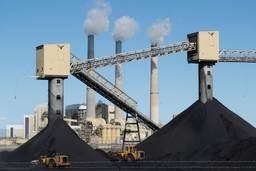How To Bury the Fossil Fuel Industry
We need to halt subsidies, enforce stricter regulations and bring fossil fuel corporations under public control.
Kate Aronoff

Keen eyes browsing through the Green New Deal resolution introduced by Rep. Alexandria Ocasio-Cortez (D-N.Y.) and Sen. Ed Markey (D-Mass.) in February might have noticed a concerning similarity between that document and the Paris climate agreement: Neither mentions fossil fuels.
To be clear, the Green New Deal is probably the best shot we have at planetary survival. Its sweeping call to get to net-zero emissions by 2030 while raising Americans’ standard of living is wildly ambitious, smart politics and firmly in line with the scientific consensus on global warming. But February’s resolution, essentially a statement of principles, couldn’t be expected to include every last detail of what is needed. Indeed, avoiding certain contentious fights for now — like those over negative emissions technologies, nuclear energy and carbon taxes — may be a shrewd move on Ocasio-Cortez and Markey’s part. But there’s one massive fight that will be impossible to avoid if we hope to achieve the goals of the Green New Deal: the one with the fossil fuel industry.
Just 100 fossil fuel producers, including both privately held and state-owned companies, have been responsible for some 71 percent of global carbon emissions since 1988. The business model of that industry is to find, dig and burn as many fossil fuels as possible. By 2050, projected new oil and gas development in the United States — barring new regulations or a drastic change in the price of oil — would unlock enough carbon to release the equivalent of the lifetime emissions of 1,000 coal-fired power plants (in 2017, the United States had 359 coal plants). Most of this would come from new drilling in the Permian basin in Texas and New Mexico and the Appalachian basin in Ohio, Pennsylvania and West Virginia.
The Intergovernmental Panel on Climate Change, meanwhile, paints a very different picture of what needs to happen. Without the wide-scale deployment of technologies to capture and store carbon dioxide from fossil fuel plants and the atmosphere — which may or may not even be feasible — global coal, oil and natural gas usage will, by 2050, have to decline by 97, 87 and 74 percent, respectively, to cap warming at 1.5 degrees Celsius. That decline ought to happen fastest in places like the United States, whose centuries of fossil-fueled economic growth should enable bringing massive amounts of renewable energy online more quickly than poorer countries. The stubborn, well-documented link between rising economic growth and rising greenhouse gas emissions also means that emissions are likely to rise outside the Global North as those economies grow and people consume more. To allow space for that to happen — that is, to avoid imposing some draconian limit on new consumption in the poorest parts of the world — emissions in wealthier countries should reach net zero by around 2030.
To get there, we will need to dramatically scale up the amount of solar and wind in our energy mix, while electrifying huge parts of the economy to run on them. Any Green New Deal will mean investing heartily to decarbonize carbon-intensive sectors like steel, cement, shipping and airlines, for which no-carbon alternatives do not currently exist. That would involve reducing demand for certain services and activities through better supply-chain management, improving existing energy efficiency and dedicating research toward decarbonization technologies at a massive scale. The Energy Transitions Commission has estimated that this massive lift would cost less than 0.5 percent of global GDP by mid-century.
Massive investments in public transit and energy-efficient affordable housing would go a long way toward decreasing the carbon footprints of our cities and towns. National fuel-efficiency and renewables standards, like the one in place at the state level in California, could require utilities and car companies to ramp up clean power usage or face harsh penalties.
Yet simply adding more renewables to the grid won’t be enough to drive down fossil fuel usage to the extent needed. Even as solar and wind have gotten cheaper and more widespread in the last several years, the share of energy they generate nationwide has remained largely flat. Fossil fuel usage and extraction have each continued to increase and show few signs of slowing down — particularly as the United States becomes a net exporter of fossil fuels. In other words, the good isn’t out-competing the bad. In such a context, placing real constraints on coal, oil and gas companies is the only way to ensure we can reach our climate goals.
In the climate policymaking world, the standard answer to curbing fossil fuel use has been a carbon tax: If emitting carbon dioxide and other greenhouse gases were more expensive, both consumers and companies would adjust their behavior accordingly. It’s a soothingly simple theory, but has struggled to gain political traction beyond Beltway wonks and academic economists. Even in deeply Democratic Washington state, voters rejected a carbon tax in a November 2018 referendum. And the belief that a tax alone could wean us off fossil fuels — that once we set a price on carbon, the market will take care of the rest — depends on the assumption that energy markets are free, efficient and hyper-responsive to price tweaks. But, as none other than Energy Secretary Rick Perry has argued, “There is no free market in the energy industry.”
There are more straightforward places to start. One would be by ending the roughly $20 billion in subsidies the U.S. government hands over to the fossil fuel industry each year at the state and federal levels, including longstanding tax giveaways. (Permanent tax breaks to the fossil fuel sector are seven times greater than those awarded to renewables.) In banning new offshore drilling exploration, the United States would follow the example already set by New Zealand. And a Green New Deal could move to end the practice of leasing federal lands and waters to drillers, as well as granting permits for the kind of new infrastructure that allows companies to export oil and gas abroad. These handouts to the fossil fuel industry are so extensive that the Stockholm Environmental Institute has estimated that as much as half of new oil and gas development would be unprofitable without them. Removing the perverse incentives that keep them afloat should be a no-brainer.
But more dramatic action may be needed — the industry’s record of funding disinformation and lobbying to tear up even basic regulations suggests it will not disappear willingly. To hasten the transition to net-zero emissions, researchers at the Next System Project have suggested the U.S. government could bring U.S.-based fossil fuel industries under public ownership by buying up 51 percent of their shares — investors could sell these voluntarily, or else be made to compulsorily — then moving swiftly to curtail production.
Of course, cutting off new extraction overnight would leave workers and communities that depend on fossil fuel employment in a lurch, and cause arguably catastrophic ripple effects throughout the U.S. economy if alternatives were not at the ready.
Whatever ownership structure is in place, living up to the values embodied in a Green New Deal will require a managed decline of the fossil fuel industry, in which the first priority is ensuring a dignified quality of life for extractive sector employees — not golden parachutes for C-suite executives.[LINK TO JEREMY’S PIECE?]
Barely out of the gate, the Green New Deal is already attracting the ire of fossil fuel industry executives and the various dark money think tanks and politicians they fund. They’ve begun fabricating price tags for the program out of whole cloth. Coal, oil and gas interests will paint whatever plan is eventually produced as an assault on fossil fuel workers out to crater the U.S. economy. So why not battle them head-on?
Kate Aronoff is a staff writer at The New Republic and author of Overheated: How Capitalism Broke the Planet — And How We Fight Back. She is co-author of A Planet To Win: Why We Need a Green New Deal and co-editor of We Own the Future: Democratic Socialism—American Style. Follow her on Twitter @katearonoff.









